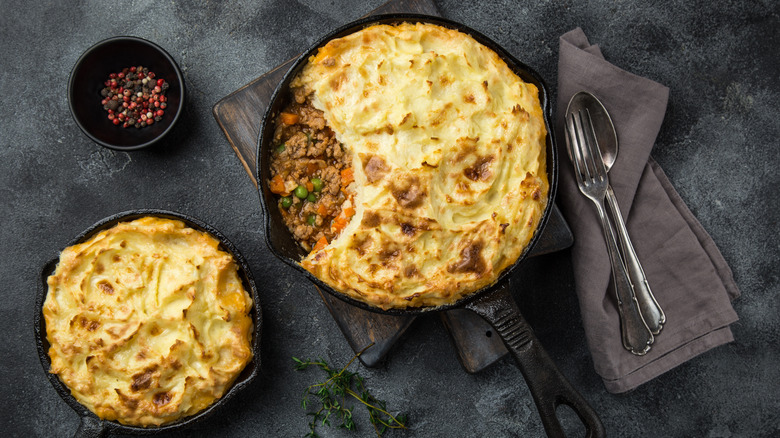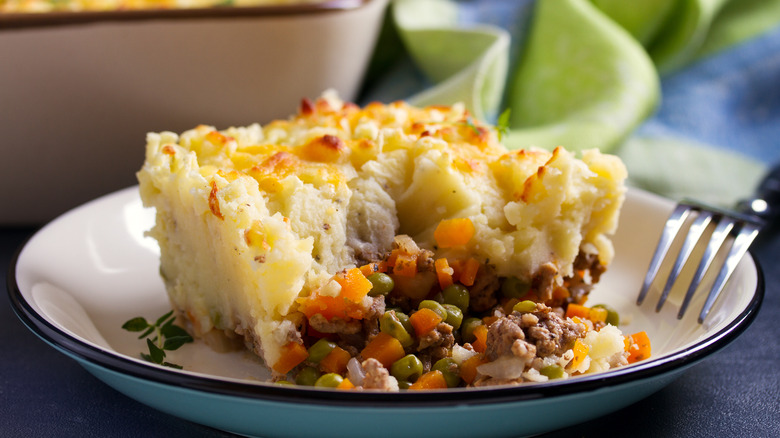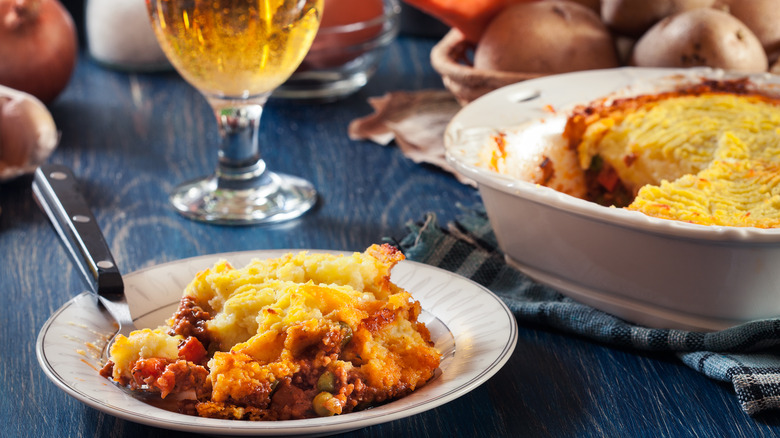The Unexpected Ingredients Used In The Original Shepherd's Pie
Peruse the menu of many a pub in Britain or Ireland, and you'll likely find shepherd's pie. It's a classic British meal, beloved and steeped in tradition. Like many traditional dishes, shepherd's pie has a murky history. According to some, the name first appeared in the mid-1800s in an English cookbook described as a Scottish dish, but similar pies crop up in cookbooks earlier still. Still others claim that shepherd's pie has Irish origins dating back to the 1700s. Regardless of the country or the exact date, it was typically a meal for the lower classes — hearty, filling, and a way to use scraps and avoid waste.
Turning any meat into a delicious dinner has long been the purpose behind pies. Some believe that "pie" is connected to the Latin word for magpie. The reasons for the linguistic link are up for debate, but one pervading theory is that pie gets its name from magpies' tendency to collect odd shiny things: In a similar way, bakers gather bits and pieces for pie filling.
Shepherd's pie lives up to these etymological origins. It would typically use lamb or mutton in the filling — hence "shepherd" in the name — but it wasn't the best cuts. Lamb was preferred, but this was a humble pie where anything goes, meat-wise, and where leftovers and unused scraps were the meats being offered. If leftovers of the Sunday roast weren't available, fish, chicken, game, or even pigeons were all perfectly acceptable ingredients.
A precursor to shepherd's pie
Although shepherd's pie is now known for its top layer of fluffy mashed potatoes, early versions included a pastry shell instead of the mashed potatoes. Earlier still, the cousin of shepherd's pie, the cottage pie, used sliced potatoes on top and bottom and included a beef, vegetable, and gravy filling. Even with some potato variation, these pies are still fairly close to what we enjoy today — but once you follow the shepherd's pie's history through the centuries, the ingredients become far more unusual by modern standards. In the 18th century, popular cookbooks used every part of the animal in pies. You'll find recipes for cow's foot and cow's tongue pies, and chicken pies include the bird's giblets. These anything-goes recipes follow in the footsteps of 17th-century mince pies, which would include ox tongue and offal (also known as the internal organs of an animal, often deer) as well as pigeons and crow. Nothing went to waste, and pies were an easy way to make the less-choice cuts and otherwise unappealing parts more flavorsome.
With its variable attitude toward meat filling, shepherd's pie is a clear descendant of these early pies. Whether relying on leftovers from previous days or utilizing the less-appealing bits of meat leftover after the best were cooked, the shepherd's pie stays true to its culinary ancestors and covers this use-everything tradition in a mashed potato layer.
A pie with history all over the world
Although the popularity of shepherd's pie is usually linked to the British Isles, countries all over the world have their own versions with equally rich histories (and equally unusual ingredients). Hachis Parmentier is the French variation; "Parmentier" as a reference to the 18th century pharmacist Antoine-Augustin Parmentier, who dedicated himself to advocating the potato — which, until he started pushing the spud, was only viewed as animal feed. The dish stays true to its humble origins, with leftover chopped meat as filling and mashed potatoes on top.
French Canadians prefer the pâté chinois, loosely translated to "Chinese pie," which combines ground beef and corn under the potato layer. This pie, like shepherd's pie, has mysterious origins, with legend crediting it to Chinese Canadian railworkers but other theories tracing it to French Canadian workers in New England.
If you want to stick to the historical tradition of combining unusual elements in your shepherd's pie, the opportunity to experiment abounds. Add in some soy sauce, edamame, and sesame seeds for an Asian-inspired shepherd's pie. Mushrooms also make an earthy, hearty substitute for meat, if you're looking to make a vegetarian shepherd's pie (which is sometimes called a "shepherdless pie"). As long as you rely on the basic structure and guiding pie principles, there's no limit to the unexpected ingredients you can use to make shepherd's pie your own.


